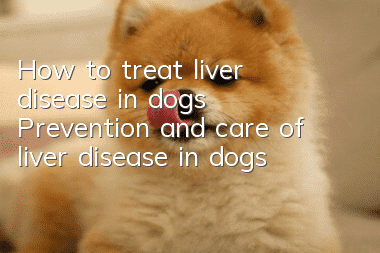How to treat liver disease in dogs Prevention and care of liver disease in dogs

What is liver disease in dogs
The liver is a large organ located directly in front of the dog’s abdomen, behind the chest cavity.
There is no single cause of liver disease, which may be hereditary, infectious, toxic, cancerous or of unknown origin.
Pesticides, rodenticides, lead, selenium, arsenic, iron, phosphorus and poisonous plants can damage the liver.
Taking antifungals, analgesics, nonsteroidal anti-inflammatory drugs, antiemetics, antibiotics, anesthetic gases, anthelmintics, corticosteroids, and diuretics can also cause liver discomfort.
What is cirrhosis
Liver disease follows an easily predictable course. As liver cells die, they are replaced by scar tissue. The liver becomes enlarged, hard, and strong, an irreversible condition called cirrhosis. Some dogs remain healthy year round, while other dogs will become bloated and jaundiced, with yellow skin, orange mucous membranes and brightly colored urine caused by bile and the accumulation of bilirubin in the blood. The stool may turn grey, and the dog may have blood clotting problems. When the liver loses its ability to function, the dog becomes very weak and eventually dies.
Causes of liver disease
There is no single cause of liver disease. It can be chronic or acute in onset, familial, hereditary, contagious, toxic, cancerous or of unknown origin, among others. Liver damage or disease can occur for a variety of reasons, including the following:
1) Ingestion or exposure to high concentrations of certain chemical toxins such as pesticides, rodenticides, lead, selenium, arsenic, iron, phosphorus and carbon tetrachloride.
2) Ingestion of certain drugs that are toxic, such as: antifungals, analgesics (including non-steroidal anti-inflammatory drugs), anticonvulsants, antibiotics, anesthetic gases, anthelmintics, corticosteroids and diuretics . Adverse drug reactions leading to hepatotoxicity after long-term use and liver damage caused by inappropriately high doses.
3) Systemic infectious diseases or other diseases, such as leptospirosis, heartworm infection, infectious canine hepatitis, canine adenovirus, diabetes, hyperadrenocorticism (Cushing's disease) and hypothyroidism .
4) Cancer (tumor), either primary (starting in the liver) or metastatic (coming from somewhere else). Hepatocellular carcinoma (common), hepatocellular adenoma, biliary tract carcinoma or adenoma, angiosarcoma, leiomyosarcoma, lymphoma, islet cell carcinoma, adenocarcinoma, transitional cell carcinoma and other forms may be involved.
5) Poisonous plants, such as blue-green algae, mushrooms ("Special reminder from "Chopper the Divine Dog": not all mushrooms, individual mushrooms can be eaten appropriately), lilies and ragweed, etc.
6) Molds, such as aflatoxin
7) Liver shunt (portosystemic shunt)
8) Idiopathic chronic hepatitis (usually with unknown autoimmunitydisease)
9) Copper-related hepatitis (usually related to dog breeds)
10) Bile duct obstruction caused by liver, tumor, pancreatitis or gallbladder stones
11) Liver tissue fibrosis
12) Vascular or circulatory disorders (congenital/birth/or developmental)
13) Biliary tract disease
14) Infectious diseases (bacteria, fungi, viruses)
15) Liver abscess
16) Trauma
Ingestion of thousands of toxic substances can damage the liver. Any heart or circulation problem that affects blood flow to the liver can also cause liver disease.
How to prevent liver disease
Many causes of liver disease are not preventable. Of course, pet cats and dogs should be kept away from potentially toxic drugs, plants, chemicals and other substances, which will prevent them from coming into contact with them. Infectious diseases should be diagnosed and treated promptly to prevent liver damage, and antibodies should be checked regularly to check the body's resistance. All dogs should be provided with a high-quality diet, high-quality water, a warm bedding and plenty of play time to maintain overall good health. Annual physical exams, including routine blood tests, can identify elevated liver enzymes, which may reflect early liver damage.
- What do dogs eat to protect their stomach? It is important to protect their stomach and treat gastrointestinal diseases in dogs.
- How to tell if your dog is fat? Is your dog overweight?
- Will your dog catch a cold if you blow the air conditioner? What should you do if your dog catches a cold if you blow the air conditioner?
- What should you pay attention to when your dog drinks water? Don’t be careless when it comes to your dog’s drinking water.
- The dog's mouth bites and shakes. Why does the dog's mouth occasionally shake and bite?
- How to cut a dog's hair? Do you know how to cut a dog's hair correctly?
- Can dogs eat raw eggs? Why can’t dogs eat egg whites?
- Common Dog Problems in Summer How to Deal with Different Dog Problems
- How to keep dogs away from skin diseases. If you do this, will you see if your dog will still be infected with skin diseases?
- What causes anorexia in dogs? Dogs will become anorexic due to lack of exercise. Hounds run at least 5KM every day.



